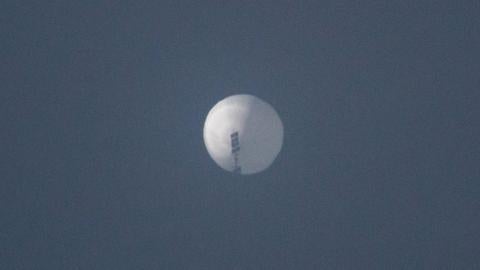“Bring down that balloon.”
That should have been the order from the US commander-in-chief when faced with a foreign reconnaissance balloon flying over Minuteman III ICBM silos.
Postponing Secretary of State Anthony Blinken’s trip to Beijing to meet with his counterpart, Foreign Minister Qin Gang, was the correct policy decision. Dangling talks with Xi Jinping was undoubtedly meant to tempt Secretary Blinken to carry on with the painstaking work of diplomacy. But negotiating guardrails for US-China competition despite the flagrant provocation of the spy balloon would have been kowtowing to the Middle Kingdom.
China’s wispy denials of responsibility for the surveillance balloon are full of hot air.
The chance that a weather balloon inadvertently navigated over US strategic bases, including Malmstrom Air Force Base in Montana, is next to nil. Scientific evidence plausibly tracks the balloon’s launch point back to central China. This was a designed provocation, albeit one in which Beijing would retain plausible deniability to limit the incident’s fallout.
Consider this past year’s record of provocations from the People’s Liberation Army (PLA). China has been ramping up air and sea provocations to push back on US and allied military forces.
Last February, a Chinese naval combatant shined a military-grade laser toward an Australian maritime patrol plane over the Arafura Sea off northern Australia. In April and May, China’s air force repeatedly buzzed Canadian CP-140 Aurora maritime patrol aircraft conducting operations to enforce sanctions on North Korea from Kadena Air Base in Japan. At the same time, a Chinese J-16 fighter intercepted and released flares and chaff in front of an Australian P-8 maritime surveillance plane on a routine patrol in the South China Sea. PLA forces swamped Taiwan’s airspace and seas, effectively erasing the median line in the Taiwan Strait, before and after then-House Speaker Nancy Pelosi’s visit to Taipei in August. And in December, a Chinese J-11 fighter came dangerously close to the nose of a US Air Force RC-135 reconnaissance plane in international airspace over the South China Sea.
China has been dialing up operational harassment to frighten the Biden administration into throttling back its forward military engagement in the Indo-Pacific region. Despite technological competition and confrontation over Taiwan, President Joe Biden asked Xi Jinping in Bali last November to allow high-level talks to help establish guardrails to ensure matters do not get out of hand.
Against this backdrop, a spy balloon offered a limited-risk ploy for gaining coercive leverage and some essential intelligence simultaneously. Further, after North Korea’s successful intrusion into South Korean airspace with a small drone, a balloon no doubt seemed like a similarly low-risk way to bring military operations to the United States. China seeks leverage by effectively saying to the United States, “If you intrude on our sphere of influence, we will intrude on your homeland.”
China has been analyzing the strength of the US alliance network in response to belligerence from Moscow and Beijing. NATO Secretary General Jens Stoltenberg’s visit to Seoul and Tokyo highlighted a burgeoning interconnectedness between the transatlantic and transpacific security allies.
Then-Secretary of Defense Lloyd Austin visited Seoul to reassure South Korea that extended deterrence was alive and well. The promise of near-continuous joint exercises of advanced aircraft, the launching of tabletop exercises to think through allied responses to the possibility of North Korean nuclear use, and South Korea’s new commitment to a free and open Indo-Pacific were a jolt to Beijing’s perceptions of control over the Asian mainland.
Even more, Japan’s defense transformation strikes Chinese officials as detrimental to its interests. Yet even Prime Minister Fumio Kishida sees Japan's need to do more to preserve peace and stability around Japan, including in the Taiwan Strait. But adding counterstrike weapons on top of severe cyber forces and a new joint command will seriously impede Beijing’s perceived ability to seize Taiwan.
Then Bongbong Marcos put the US-Philippine alliance back on the course that President Benigno Aquino III was following before Rodrigo Duterte traded in the partnership in the hope of winning Chinese investments.
In Manila, Secretary Austin and Secretary Calvito Galvez, Jr. announced that, under the 2014 Enhanced Defense Cooperation Agreement (EDCA), the United States would gain access to four new locations in Luzon and Palawan. That is, in contrast to the five existing locations in Central Luzon, Palawan, Cebu, and Mindanao, US forces would be prepositioning hardware, training, and operating prime real estate for keeping the peace in the South China Sea and the Philippine Sea adjacent to the Bashi Channel between the Philippines and Taiwan.
Austin is two for two in boosting America’s most vital alliance in Southeast Asia. He negotiated the renewal of the US Status of Forces Agreement in 2021 after Duterte realized Philippine security was threatened without it.
Washington, Canberra, and London will soon be making decisions about undersea warfare and high-technology cooperation as part of the Australia-UK-US (AUKUS) defense partnership, and this past week the US and India made sudden progress with the initiative on Critical and Emerging Technology (iCET). In both cases, the US is leveraging critical technology to elevate the capability of two partners who anchor the Indo-Pacific.
The United States is redrawing the regional force posture and strengthening the global network of allies and partners to bring about “integrated deterrence” and create a more favorable security architecture.
After temporarily allowing the spy balloon to suspend military air operations in Montana, the administration belatedly made the right call by postponing the high-level diplomatic talks in Beijing. The US must be responsible but strong.
As for the balloon, what comes up must come down. It must be done in a way that sends a strong message that the United States will not accept Beijing’s false choice between peace on China’s terms or war. Instead, deterrence will be maintained to keep the peace and allow for diplomacy. It’s up to Chinese officials to get serious about playing within a rules-based system.















